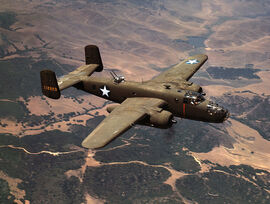
A B-25C Mitchell over California in 1942.
The North American B-25 Mitchell was a medium bomber that was used by the United States Army Air Forces during World War II.[1]
History[]
Designed and built by a company with no previous experience of bombers, multi engined aircraft or high performance warplanes, the B-25 - named in honour of the Air Corps officer Billy Mitchell, who was court martialled for his belief in air power - has often been described as the best World War 2 aircraft in its class, and was made in larger quantities than any other American twin engined warplane.[2]
The design team led by Lee Atwood and Ray Rice initially created the NA-40 in response to U.S. Army Specification 98-102 for a twin engine medium bomber.,[3] which gave way to a sleeker, more powerful machine when the Army issued a revised specification.[4]
The prototype, now known as the NA-40-1 Attack Bomber, was completed with two 1,100 hp Pratt and Whitney R-1830-s6c3-g radials in early 1939, and was flown in January. In mid February the engines were replaced by a pair of 1,200 hp Wright Cyclone GR-2600-A7J radials, resulting in the revised designation of NA-40-2 (NA-40B). Initial armament consisted of a hand held 0.3 in M2 browning with 300 rounds, three 0.3 machine guns fixed in the wings with 500 rounds each, single guns on hand held mountings in the mid upper and rear lower positions with 500 rounds each, and 1,200 lbs of bombs.[5]
Following a brief test programme, the Air Corps suggested a number of design changes, resulting in North American redesigning the aircraft to meet a revised specification as the NA-62. This featured increased bomb load capability, obtained by rearranging the internal bomb stowage while replacing the raised cockpit with one in line with the top of the fuselage. In addition, the wing attachment point was lowered by several feet to provide an improved mainspar location,[5] the engine nacelles were extended aft of the wing, a 0.5 in machine gun was fitted in a hand held mounting in the tail, and crew accommodation was increased from three to five.[N 1]
Army approval for the new design was obtained on 10 September 1939, with a contract for the construction of 184 examples, ordered off the drawing board as the B-25, being issued ten days later. Following delivery of a static test example to Wright Field on 4 July 1940, the first flying B-25 made its initial flight on 19 August 1940. Powered by two 1,700 hp Wright-Cyclone R-2600-9 radials, this variant was capable of 322 mph at a gross weight of 27,310 lb. After completion of the first nine examples, the design was modified by re-setting the outer wing panels to the horizontal position, in order to eliminate the directional instability encountered during bombing run tests carried out at Wright Field.[6]
Specifications (B-25J Mitchell)[]
- Crew: six (one pilot, one co-pilot, navigator/bombardier, turret gunner/engineer, radio operator/waist gunner, tail gunner)
- Length: 52 ft 11 in (16.13 m)
- Wingspan: 67 ft 7 in (20.60 m)
- Height: 16 ft 4 in (4.98 m)
- Wing area: 610 sq ft (56.7 m²)
- Empty weight: 19,480 lb (8,855 kg)
- Max. takeoff weight: 35,000 lb (15,910 kg)
- Powerplant: Two Wright R-2600-92 14-cylinder air-cooled radial engines rated at 1,700 hp (1,267 kW) each
- Max. speed: 272 mph (438 km/h) at 13,000 ft (3,960 m)
- Cruising speed: 230 mph (370 km/h)
- Range: 1,350 mi (1,174 nmi, 2,174 km)
- Service ceiling: 24,200 ft (7,378 m)
- Gun armament: Twelve .50 in (12.7 mm) and .30 in (7.62 mm) MGs and eighteen .50 in (12.7 mm) and .30 in (7.62 mm) MGs on the B-25H (Six on immediate nose)
- Hardpoints: 2,000 lb (900 kg) ventral shackles to hold one external Mark 13 torpedo
- Rocket armament: Racks for eight 5 in (130 mm) high velocity aircraft rockets (HVAR)
- Bombload: Six 1,000 lb (1,360 kg) bombs
References[]
Notes[]
Sources[]
- ↑ Lüdeke, Alexander. Weapons of World War II. Parragon Books Ltd. 2007. ISBN 140750195X
- ↑ Gunston, Bill. Illustrated Directory of Fighting Aircraft of World War II. Salamander Books. 1988. ISBN 0-86101-390-5 Pages 440/442
- ↑ Green, William. Famous Bombers of the Second World War. Purnell Book Services. 1975. Page 21.
- ↑ Gunston, Bill. Salamander Books. 1988. Page 442
- ↑ 5.0 5.1 Green, William. Famous Bombers of the Second World War Page 22.
- ↑ 6.0 6.1 Green, William. Famous Bombers of the Second World War Page 23.
| |||||||||||||||||||||||||||||||||||||||||||||||||||||
